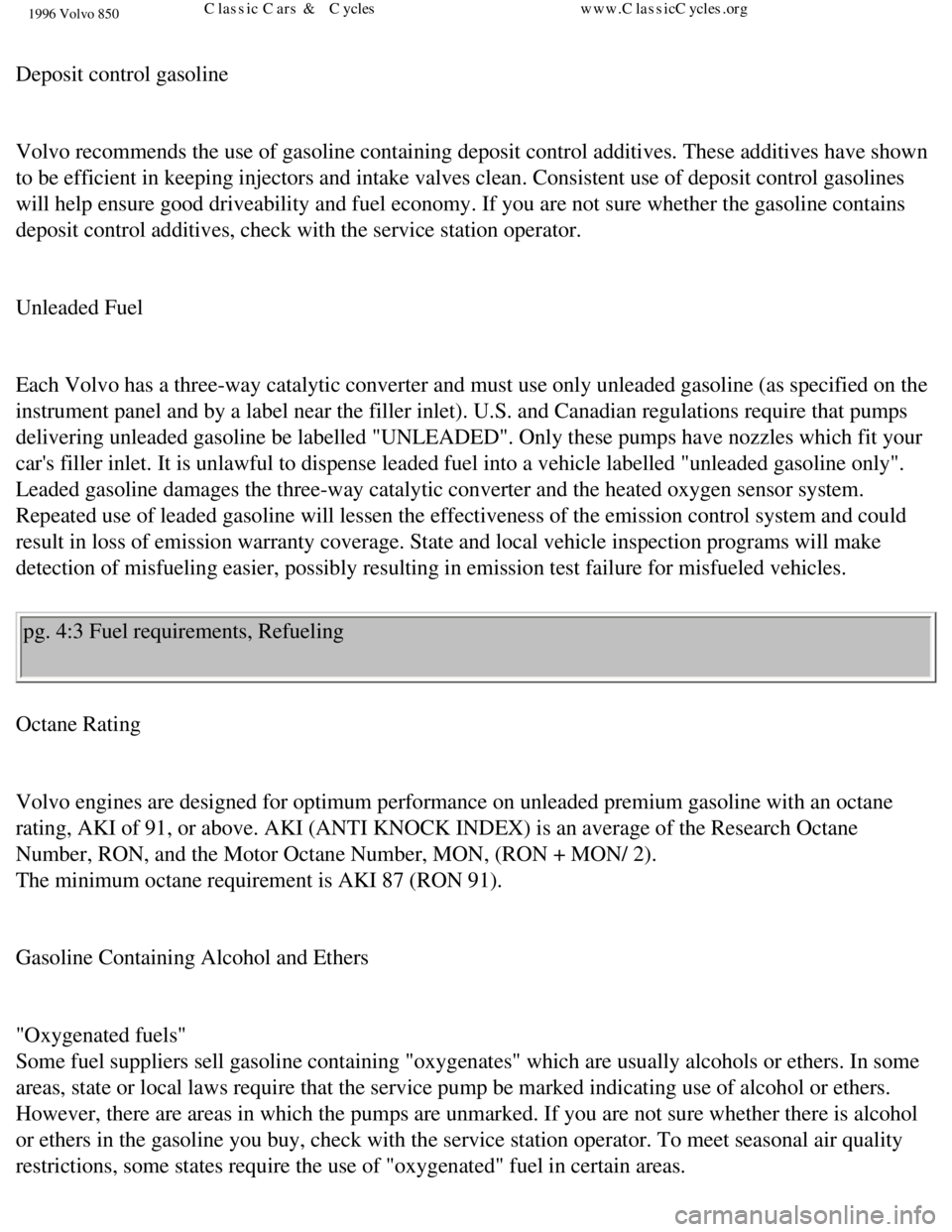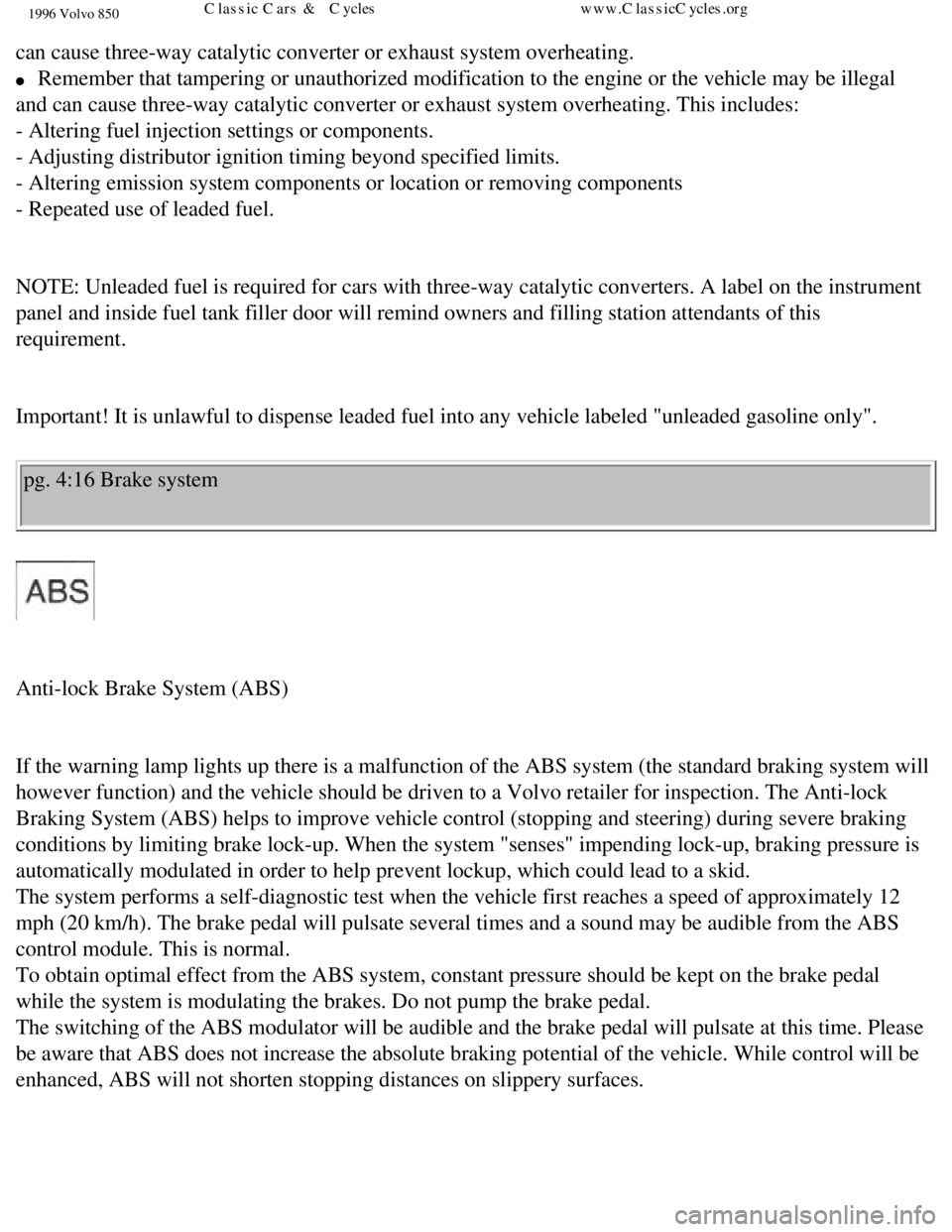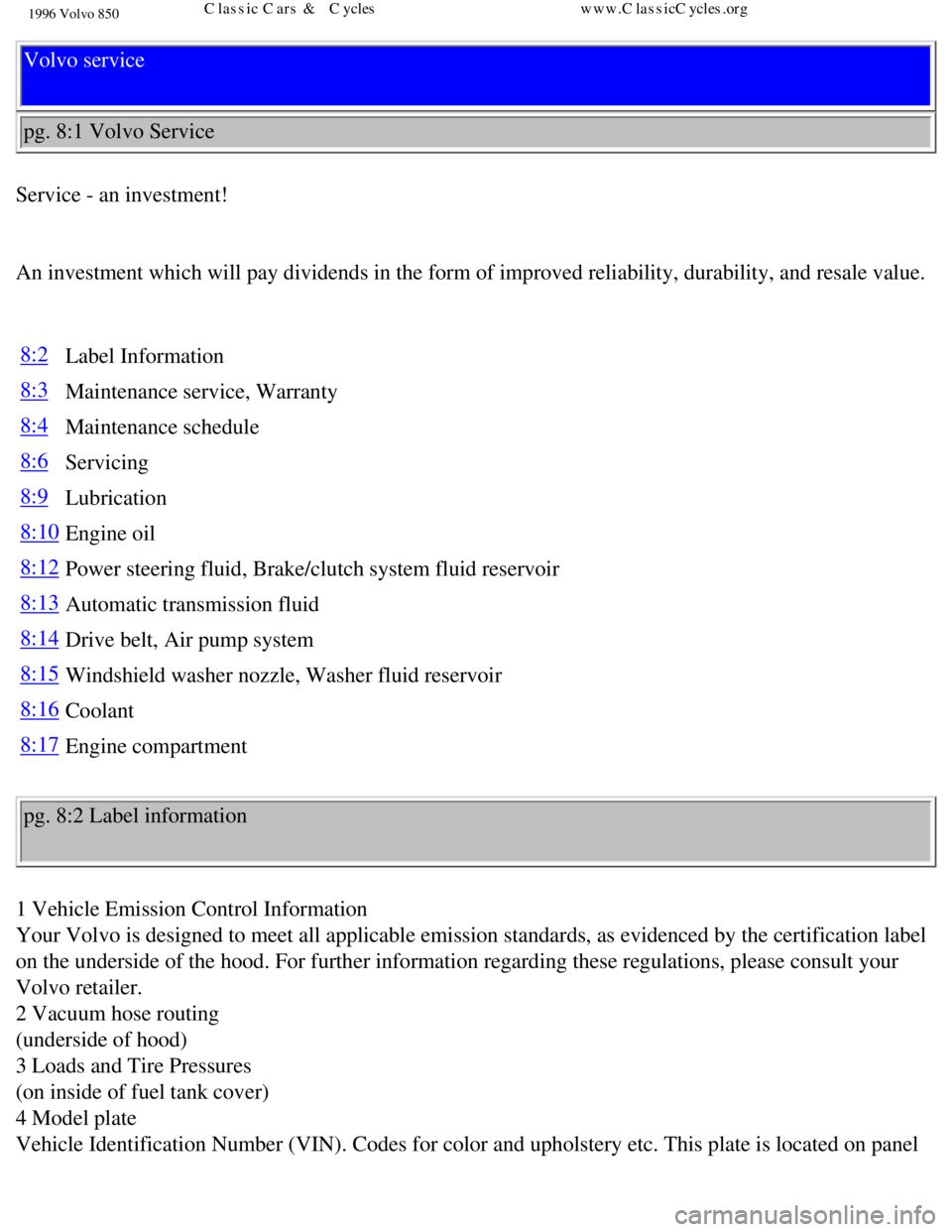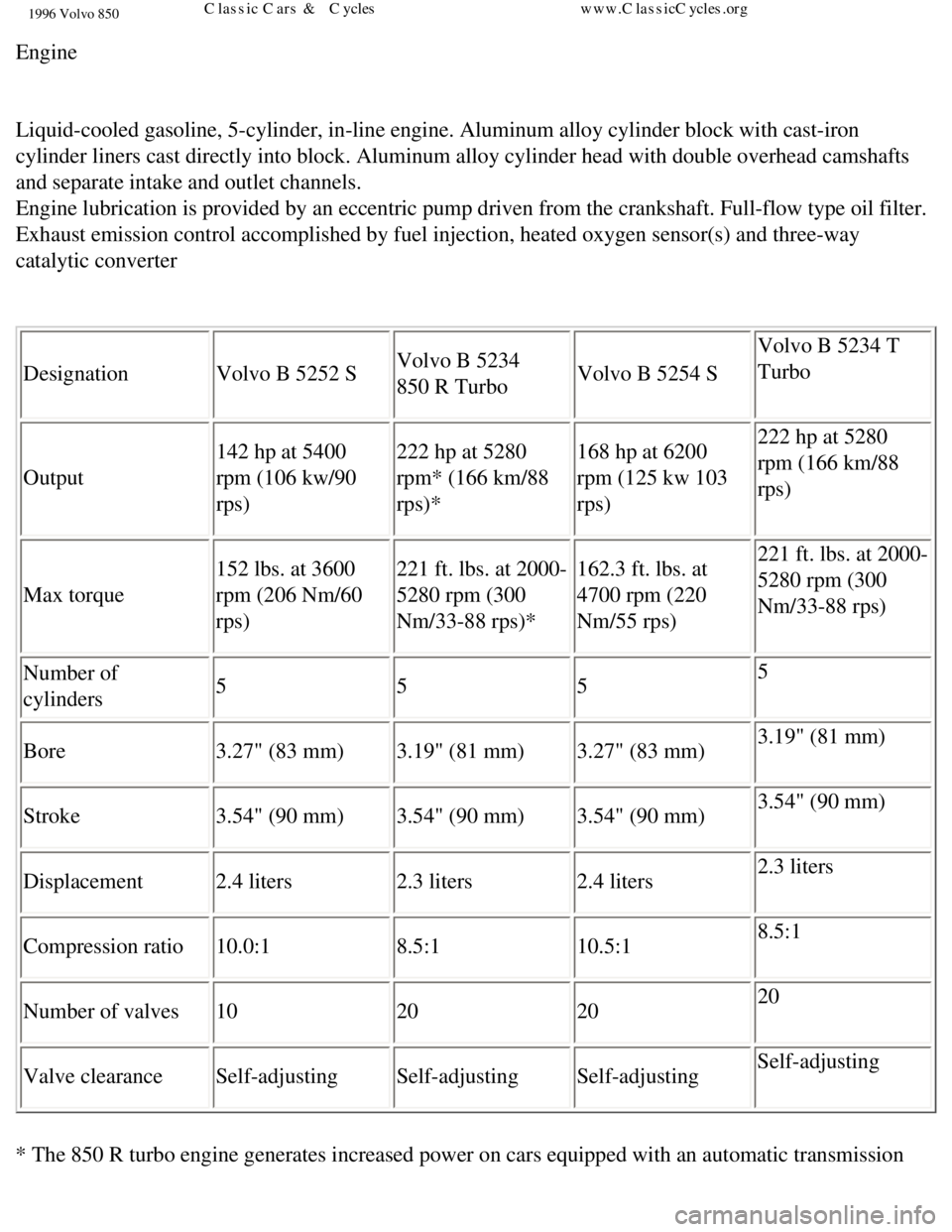fuel pump VOLVO 850 1996 Owners Manual
[x] Cancel search | Manufacturer: VOLVO, Model Year: 1996, Model line: 850, Model: VOLVO 850 1996Pages: 265, PDF Size: 4.57 MB
Page 161 of 265

1996 Volvo 850
Deposit control gasoline
Volvo recommends the use of gasoline containing deposit control additive\
s. These additives have shown
to be efficient in keeping injectors and intake valves clean. Consistent\
use of deposit control gasolines
will help ensure good driveability and fuel economy. If you are not sure\
whether the gasoline contains
deposit control additives, check with the service station operator.
Unleaded Fuel
Each Volvo has a three-way catalytic converter and must use only unleade\
d gasoline (as specified on the
instrument panel and by a label near the filler inlet). U.S. and Canadi\
an regulations require that pumps
delivering unleaded gasoline be labelled "UNLEADED". Only these pumps ha\
ve nozzles which fit your
car's filler inlet. It is unlawful to dispense leaded fuel into a vehicl\
e labelled "unleaded gasoline only".
Leaded gasoline damages the three-way catalytic converter and the heated\
oxygen sensor system.
Repeated use of leaded gasoline will lessen the effectiveness of the emi\
ssion control system and could
result in loss of emission warranty coverage. State and local vehicle in\
spection programs will make
detection of misfueling easier, possibly resulting in emission test fail\
ure for misfueled vehicles. pg. 4:3 Fuel requirements, Refueling
Octane Rating
Volvo engines are designed for optimum performance on unleaded premium g\
asoline with an octane
rating, AKI of 91, or above. AKI (ANTI KNOCK INDEX) is an average of t\
he Research Octane
Number, RON, and the Motor Octane Number, MON, (RON + MON/ 2).
The minimum octane requirement is AKI 87 (RON 91).
Gasoline Containing Alcohol and Ethers
"Oxygenated fuels"
Some fuel suppliers sell gasoline containing "oxygenates" which are usua\
lly alcohols or ethers. In some
areas, state or local laws require that the service pump be marked indic\
ating use of alcohol or ethers.
However, there are areas in which the pumps are unmarked. If you are not\
sure whether there is alcohol
or ethers in the gasoline you buy, check with the service station operat\
or. To meet seasonal air quality
restrictions, some states require the use of "oxygenated" fuel in certai\
n areas.
file:///K|/ownersdocs/1996/1996_850/96850_401.htm (3 of 8)12/30/2006 9\
:59:32 AMClassic Cars & Cycles www.ClassicCycles.org
Page 162 of 265

1996 Volvo 850
Volvo allows the use of the following "oxygenated fuels"; however, the o\
ctane ratings listed on this page
must still be met.
Alcohol -- Ethanol
Fuels containing up to 10% ethanol by volume may be used.
Ethanol may also be referred to as Ethyl alcohol, or "Gasohol".
Ethers -- MTBE
Fuels containing up to 15% MTBE may be used.
Refueling
The fuel tank filler cap is located behind the door on the left rear fen\
der. Open cap slowly during hot
weather conditions.
When filling, position the cap in the special bracket on the door.
NOTE: Turn the ignition off or to position I when refueling. If the igni\
tion is on, an incorrect reading
could occur in the fuel gauge (low fuel will be indicated).
After filling the tank, install the cap and turn until a "click" is hear\
d.
The fuel tank is designed to hold approximately 19.3 US gals (73 liters\
) with sufficient volume left over
to accommodate possible expansion of the fuel in hot weather. The "usabl\
e" tank capacity will be
somewhat less than the specified maximum. When the fuel level is low, su\
ch factors as ambient
temperature, the fuel's "vapor pressure" characteristics, and terrain ca\
n affect the fuel pumps' ability to
supply the engine with an adequate supply of fuel. Therefore, it is advi\
sable to refuel as soon as possible
when the needle nears the red zone, or when the fuel warning light comes\
on.
CAUTION: Do not refuel with the engine running. After refueling, close t\
he fuel filler cap by turning
it clockwise until it clicks into place.
NOTE: if the filler cap is not closed tightly or if the engine is runnin\
g when the car is refueled, the
Malfunction Indicator Lamp may indicate a fault. Use only Volvo original\
or approved fuel filler caps.
file:///K|/ownersdocs/1996/1996_850/96850_401.htm (4 of 8)12/30/2006 9\
:59:32 AMClassic Cars & Cycles www.ClassicCycles.org
Page 181 of 265

1996 Volvo 850
can cause three-way catalytic converter or exhaust system overheating.
l Remember that tampering or unauthorized modification to the engine or th\
e vehicle may be illegal
and can cause three-way catalytic converter or exhaust system overheatin\
g. This includes:
- Altering fuel injection settings or components.
- Adjusting distributor ignition timing beyond specified limits.
- Altering emission system components or location or removing components\
- Repeated use of leaded fuel.
NOTE: Unleaded fuel is required for cars with three-way catalytic conver\
ters. A label on the instrument
panel and inside fuel tank filler door will remind owners and filling st\
ation attendants of this
requirement.
Important! It is unlawful to dispense leaded fuel into any vehicle label\
ed "unleaded gasoline only".
pg. 4:16 Brake system
Anti-lock Brake System (ABS)
If the warning lamp lights up there is a malfunction of the ABS system (\
the standard braking system will
however function) and the vehicle should be driven to a Volvo retailer \
for inspection. The Anti-lock
Braking System (ABS) helps to improve vehicle control (stopping and s\
teering) during severe braking
conditions by limiting brake lock-up. When the system "senses" impending\
lock-up, braking pressure is
automatically modulated in order to help prevent lockup, which could lea\
d to a skid.
The system performs a self-diagnostic test when the vehicle first reache\
s a speed of approximately 12
mph (20 km/h). The brake pedal will pulsate several times and a sound \
may be audible from the ABS
control module. This is normal.
To obtain optimal effect from the ABS system, constant pressure should b\
e kept on the brake pedal
while the system is modulating the brakes. Do not pump the brake pedal. \
The switching of the ABS modulator will be audible and the brake pedal w\
ill pulsate at this time. Please
be aware that ABS does not increase the absolute braking potential of th\
e vehicle. While control will be
enhanced, ABS will not shorten stopping distances on slippery surfaces. \
file:///K|/ownersdocs/1996/1996_850/96850_412.htm (5 of 10)12/30/2006 \
9:59:35 AMClassic Cars & Cycles www.ClassicCycles.org
Page 211 of 265

1996 Volvo 850
examine the curved metal wire to see if it is broken. If so, put in a ne\
w fuse of the same color and
amperage (written on the fuse). Spare fuses are stored in a compartmen\
t in the fuse box.
If fuses burn out repeatedly, have the electrical system tested at a Vol\
vo retailer.
If you find it difficult to remove a fuse, you will find a special fuse \
tool clipped in the fuse box. pg. 6:14 Fuses
Location * Amperage
1 Fuel injection, distributor ignition system, automatic gearbox 15A
2 Fuel pump 15A
3 Interior courtesy lights 10A
4 –
5 ECC blower (speed 4) 30A
6 Central locking system 25A
7 Audio system 15A
8 –
9 ABS 30A
10 Electrically heated rear seat 15A
11 Electrically heated rear window and side-door mirrors 30A
12 Brake lights 10A
13 Hazard warning flashers, headlight flashers 15A
14 ABS 30A
15 OBD socket, courtesy lights, open door warning lights,
remote operated central locking system 10A
16 Power antenna, electrical connector for trailer, accessories 30A
17 Key reminder, seat belt reminder 10A
18 Front fog lights 15A
19 Left high beam 15A
20 Right high beam, high beam indicator light 15A
21 Left low beam 15A
22 Right low beam 15A
23 Left parking lights, license plate lights 10A
24 Right parking lights 10A
25 Rear fog light, rear fog light indicator light 10A
26 Heated front/rear seats, power side-view mirrors 25A
27 Backup lights, direction indicators 15A
file:///K|/ownersdocs/1996/1996_850/96850_613.htm (2 of 8)12/30/2006 9\
:59:46 AMClassic Cars & Cycles www.ClassicCycles.org
Page 226 of 265

1996 Volvo 850
Volvo service
pg. 8:1 Volvo Service
Service - an investment!
An investment which will pay dividends in the form of improved reliabili\
ty, durability, and resale value.
8:2 Label Information
8:3Maintenance service, Warranty
8:4Maintenance schedule
8:6Servicing
8:9Lubrication
8:10Engine oil
8:12Power steering fluid, Brake/clutch system fluid reservoir
8:13Automatic transmission fluid
8:14Drive belt, Air pump system
8:15Windshield washer nozzle, Washer fluid reservoir
8:16Coolant
8:17Engine compartment
pg. 8:2 Label information
1 Vehicle Emission Control Information
Your Volvo is designed to meet all applicable emission standards, as evi\
denced by the certification label
on the underside of the hood. For further information regarding these re\
gulations, please consult your
Volvo retailer.
2 Vacuum hose routing
(underside of hood)
3 Loads and Tire Pressures
(on inside of fuel tank cover)
4 Model plate
Vehicle Identification Number (VIN). Codes for color and upholstery et\
c. This plate is located on panel
file:///K|/ownersdocs/1996/1996_850/96850_801.htm (1 of 6)12/30/2006 9\
:59:50 AMClassic Cars & Cycles www.ClassicCycles.org
Page 234 of 265

1996 Volvo 850
Unstable idle, misfiring, or poor emission control is often caused by le\
aking vacuum hoses or
connections. Check all vacuum hoses and connections.
Checking and adjusting idle air control system
Your Volvo is equipped with an electronically controlled idle air contro\
l system that requires no
checking or adjustment.
Timing belt
For proper functioning of the vehicle and its emission control systems, \
Volvo recommends that the
timing belt be replaced every 70,000 miles (112,000 km).
Fuel system cap, tank and lines and connections
The effectiveness of the fuel system to contain hydrocarbons is dependen\
t largely on a leak-free system.
Check for proper sealing of the gasoline filler cap which contains "O" r\
ing type seals.
Fuel (line) filter
The fuel line filter is located next to the fuel pump. For proper functi\
oning of the vehicle and its
emission control systems, the fuel line filter should be replaced at 100\
,000 miles (160,000 km). The
filter is replaced as one complete unit. Replace more frequently if cont\
aminated fuel is introduced into
the tank (or if there is reason to suspect that this has occurred).
Charge air cooler (Intercooler)
The B 5234 Turbo engine employs a turbo-compressor to force air into the\
engine inlet manifold and a
charge air cooler to cool the compressed inlet air. The resulting increa\
se in air flow raises pressure in the
intake manifold by approx. 8.7 psi (over atmospheric pressure) and eng\
ine power output by approx. 50
horsepower over that developed by the normally-aspirated engine. The cha\
rge air cooler (which
resembles a radiator) is located between the turbo-compressor and inlet\
manifold.
file:///K|/ownersdocs/1996/1996_850/96850_806.htm (3 of 11)12/30/2006 \
9:59:52 AMClassic Cars & Cycles www.ClassicCycles.org
Page 252 of 265

1996 Volvo 850
Engine
Liquid-cooled gasoline, 5-cylinder, in-line engine. Aluminum alloy cylin\
der block with cast-iron
cylinder liners cast directly into block. Aluminum alloy cylinder head w\
ith double overhead camshafts
and separate intake and outlet channels.
Engine lubrication is provided by an eccentric pump driven from the cran\
kshaft. Full-flow type oil filter.
Exhaust emission control accomplished by fuel injection, heated oxygen s\
ensor(s) and three-way
catalytic converter
Designation Volvo B 5252 S Volvo B 5234
850 R Turbo Volvo B 5254 S Volvo B 5234 T
Turbo
Output 142 hp at 5400
rpm (106 kw/90
rps) 222 hp at 5280
rpm* (166 km/88
rps)* 168 hp at 6200
rpm (125 kw 103
rps) 222 hp at 5280
rpm (166 km/88
rps)
Max torque 152 lbs. at 3600
rpm (206 Nm/60
rps) 221 ft. lbs. at 2000-
5280 rpm (300
Nm/33-88 rps)* 162.3 ft. lbs. at
4700 rpm (220
Nm/55 rps) 221 ft. lbs. at 2000-
5280 rpm (300
Nm/33-88 rps)
Number of
cylinders 5
5 5 5
Bore 3.27" (83 mm) 3.19" (81 mm) 3.27" (83 mm) 3.19" (81 mm)
Stroke 3.54" (90 mm) 3.54" (90 mm) 3.54" (90 mm) 3.54" (90 mm)
Displacement 2.4 liters 2.3 liters 2.4 liters 2.3 liters
Compression ratio 10.0:1 8.5:1 10.5:1 8.5:1
Number of valves 10 20 20 20
Valve clearance Self-adjusting Self-adjusting Self-adjusting Self-adjusting
* The 850 R turbo engine generates increased power on cars equipped with\
an automatic transmission
file:///K|/ownersdocs/1996/1996_850/96850_901.htm (3 of 7)12/30/2006 9\
:59:55 AMClassic Cars & Cycles www.ClassicCycles.org